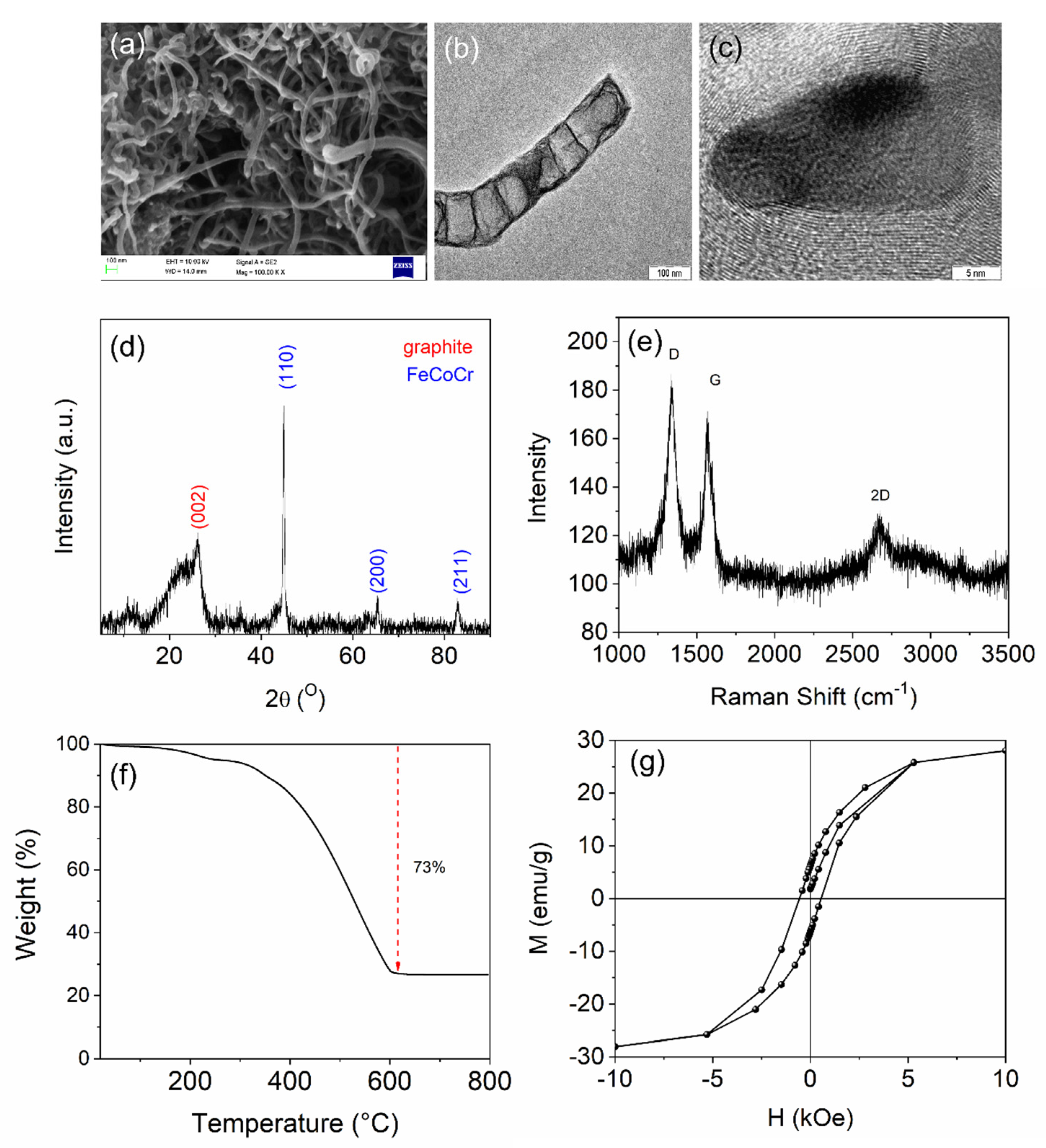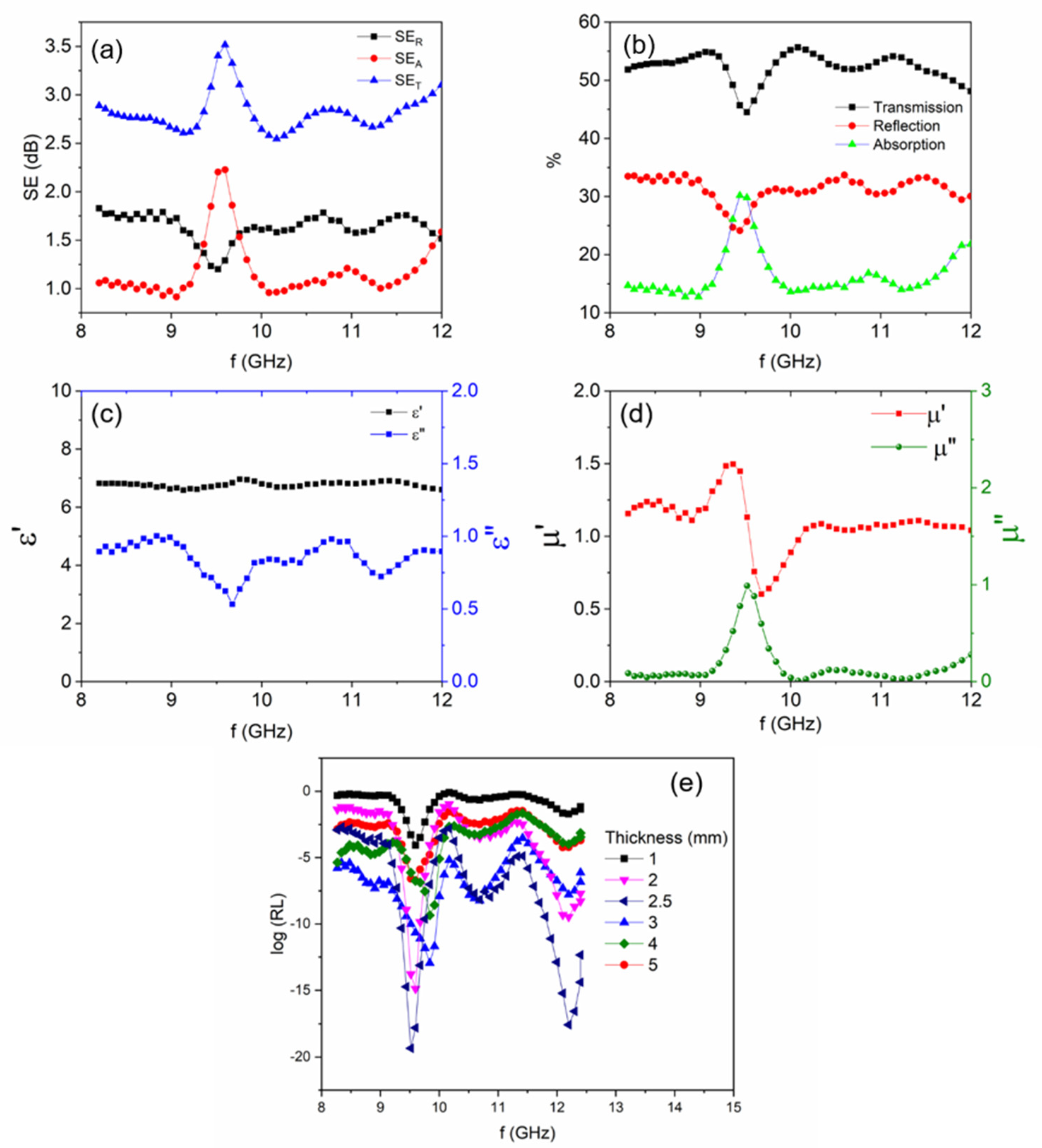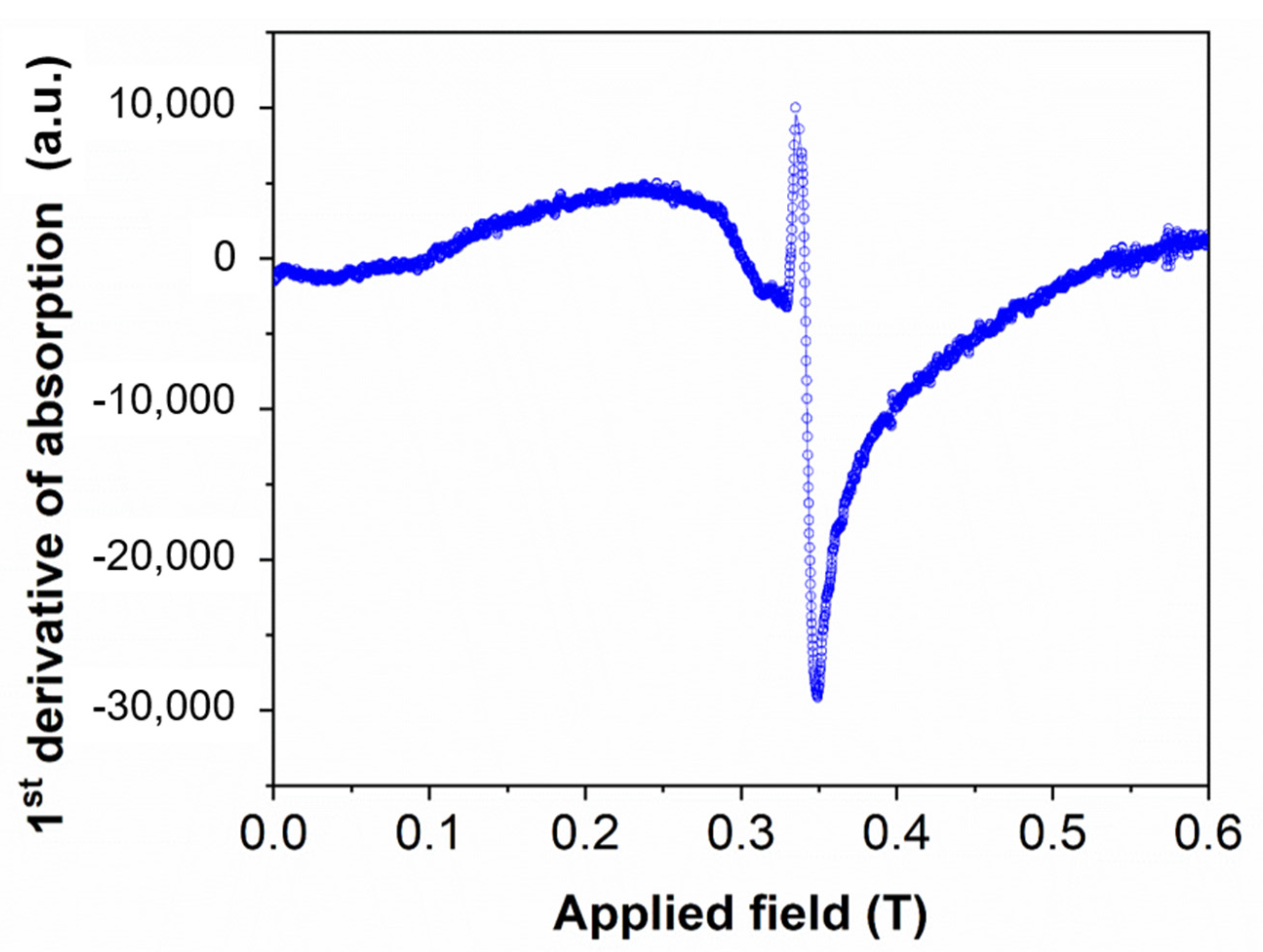Tailoring Microwave Absorption via Ferromagnetic Resonance and Quarter-Wave Effects in Carbonaceous Ternary FeCoCr Alloy/PVDF Polymer Composites
Abstract
1. Introduction
2. Experimental Details
3. Results and Discussion
4. EMI Shielding Properties of the Composite
5. EPR Studies for Validation of Ferromagnetic Resonance (FMR)
6. Conclusions
Supplementary Materials
Author Contributions
Funding
Acknowledgments
Conflicts of Interest
References
- Rodrigue, G.P. A Generation of Microwave Ferrite Devices. Proc. IEEE 1988, 76, 121–137. [Google Scholar] [CrossRef]
- Petrov, V.M.; Gagulin, V.V. Microwave Absorbing Materials. Inorg. Mater. 2001, 37, 93–98. [Google Scholar] [CrossRef]
- Harris, V.G.; Geiler, A.; Chen, Y.; Dae, S.; Wu, M.; Yang, A.; Chen, Z.; He, P.; Parimi, P.V.; Zuo, X.; et al. Recent Advances in Processing and Applications of Microwave Ferrites. J. Magn. Magn. Mater. 2009, 321, 2035–2047. [Google Scholar] [CrossRef]
- Danfeng, Z.; Fangxing, X.; Jin, L.; Zhenda, Y.; Min, Z. Electromagnetic Characteristics and Microwave Absorption Properties of Carbon-Encapsulated Cobalt Nanoparticles in 2–18-GHz Frequency Range. Carbon 2014, 80, 103–111. [Google Scholar] [CrossRef]
- Saini, S.; Kumar, P.; Gupta, P.; Kant, R.; Khanna, M.K.; Jhajharia, P.; Kuanr, B.K.; Kumar, V. Shielding the Future: The Role of Innovative Materials in Electromagnetic Interference Mitigation. J. Alloys Compd. 2025, 1022, 179969. [Google Scholar] [CrossRef]
- Redlarski, G.; Lewczuk, B.; Żak, A.; Koncicki, A.; Krawczuk, M.; Piechocki, J.; Jakubiuk, K.; Tojza, P.; Jaworski, J.; Ambroziak, D.; et al. The Influence of Electromagnetic Pollution on Living Organisms: Historical Trends and Forecasting Changes. BioMed Res. Int. 2015, 2015, 234098. [Google Scholar] [CrossRef]
- EMI Shielding of Metals, Alloys, and Composites. In Materials for Potential EMI Shielding Applications; Elsevier: Amsterdam, The Netherlands, 2020; pp. 341–355. ISBN 978-0-12-817590-3.
- Li, G.; Wang, L.; Li, W.; Xu, Y. Mesoporous Fe/C and Core-Shell Fe-Fe3C@C Composites as Efficient Microwave Absorbents. Microporous Mesoporous Mater. 2015, 211, 97–104. [Google Scholar] [CrossRef]
- Bateer, B.; Wang, L.; Zhao, L.; Yu, P.; Tian, C.; Pan, K.; Fu, H. A Novel Fe3C/Graphitic Carbon Composite with Electromagnetic Wave Absorption Properties in the C-Band. RSC Adv 2015, 5, 60135–60140. [Google Scholar] [CrossRef]
- Chaudhary, R.P.; Mohanty, S.K.; Koymen, A.R. Novel Method for Synthesis of Fe Core and C Shell Magnetic Nanoparticles. Carbon 2014, 79, 67–73. [Google Scholar] [CrossRef]
- Wang, T.; Wang, H.; Chi, X.; Li, R.; Wang, J. Synthesis and Microwave Absorption Properties of Fe–C Nanofibers by Electrospinning with Disperse Fe Nanoparticles Parceled by Carbon. Carbon 2014, 74, 312–318. [Google Scholar] [CrossRef]
- Kumar, R.; Choudhary, H.K.; Pawar, S.P.; Bose, S.; Sahoo, B. Carbon Encapsulated Nanoscale Iron/Iron-Carbide/Graphite Particles for EMI Shielding and Microwave Absorption. Phys. Chem. Chem. Phys. 2017, 19, 23268–23279. [Google Scholar] [CrossRef]
- Choudhary, H.K.; Kumar, R.; Pawar, S.P.; Sundararaj, U.; Sahoo, B. Enhancing Absorption Dominated Microwave Shielding in Co@C–PVDF Nanocomposites through Improved Magnetization and Graphitization of the Co@C-Nanoparticles. Phys. Chem. Chem. Phys. 2019, 21, 15595–15608. [Google Scholar] [CrossRef]
- Choudhary, H.K.; Kumar, R.; Pawar, S.P.; Sundararaj, U.; Sahoo, B. Effect of Morphology and Role of Conductivity of Embedded Metallic Nanoparticles on Electromagnetic Interference Shielding of PVDF-Carbonaceous-Nanofiller Composites. Carbon 2020, 164, 357–368. [Google Scholar] [CrossRef]
- Pawar, S.P.; Stephen, S.; Bose, S.; Mittal, V. Tailored Electrical Conductivity, Electromagnetic Shielding and Thermal Transport in Polymeric Blends with Graphene Sheets Decorated with Nickel Nanoparticles. Phys. Chem. Chem. Phys. 2015, 17, 14922–14930. [Google Scholar] [CrossRef] [PubMed]
- Kumar, R.; Choudhary, H.K.; Anupama, A.V.; Menon, A.V.; Pawar, S.P.; Bose, S.; Sahoo, B. Nitrogen Doping as a Fundamental Way to Enhance the EMI Shielding Behavior of Cobalt Particle-Embedded Carbonaceous Nanostructures. New J. Chem. 2019, 43, 5568–5580. [Google Scholar] [CrossRef]
- Bai, Z.; Ju, Z.; Wang, L.; Sun, B.; Sun, C.; Xu, L.; Qian, Y. Fe3BO5@carbon Core-Shell Urchin-like Structures Prepared via a One-Step Co-Pyrolysis Method. Mater. Lett. 2011, 65, 2479–2481. [Google Scholar] [CrossRef]
- Kumar, R.; Sahoo, B. One-Step Pyrolytic Synthesis and Growth Mechanism of Core-Shell Type Fe/Fe3C-Graphite Nanoparticles Embedded Carbon Globules. Nano-Struct. Nano-Objects 2018, 16, 77–85. [Google Scholar] [CrossRef]
- Kuang, D.; Hou, L.; Wang, S.; Yu, B.; Lianwen, D.; Lin, L. Enhanced Electromagnetic Wave Absorption of Ni–C Core-Shell Nanoparticles by HCP-Ni Phase Enhanced Electromagnetic Wave Absorption of Ni–C Core-Shell Nanoparticles by HCP-Ni Phase. Mater. Res. Express 2018, 5, 095013. [Google Scholar] [CrossRef]
- Kumar, R.; Sahoo, B. Investigation of Disorder in Carbon Encapsulated Core-Shell Fe/Fe3C Nanoparticles Synthesized by One-Step Pyrolysis. Diam. Relat. Mater. 2018, 90, 62–71. [Google Scholar] [CrossRef]
- Bhattacharjee, Y.; Bose, S. Core − Shell Nanomaterials for Microwave Absorption and Electromagnetic Interference Shielding: A Review. ACS Appl. Nano Mater. 2021, 4, 949–972. [Google Scholar] [CrossRef]
- Ding, N.; Yananose, K.; Rizza, C.; Fan, F.-R.; Dong, S.; Stroppa, A. Magneto-Optical Kerr Effect in Ferroelectric Antiferromagnetic Two-Dimensional Heterostructures. ACS Appl. Mater. Interfaces 2023, 15, 22282–22290. [Google Scholar] [CrossRef] [PubMed]
- Bhattacharjee, Y.; Chatterjee, D.; Bose, S. Core-Multishell Heterostructure with Excellent Heat Dissipation for 1c00278. ACS Appl. Mater. Interfaces 2018, 10, 30762–30773. [Google Scholar] [CrossRef] [PubMed]
- Bisen, O.Y.; Atif, S.; Mallya, A.; Nanda, K.K. Self-Assembled TMD Nanoparticles on N-Doped Carbon Nanostructures for Oxygen Reduction Reaction and Electrochemical Oxygen Sensing Thereof. ACS Appl. Mater. Interfaces 2022, 14, 5134–5148. [Google Scholar] [CrossRef]
- Fang, F.F.; Choi, H.J. Noncovalent Self-Assembly of Carbon Nanotube Wrapped Carbonyl Iron Particles and Their Magnetorheology. J. Appl. Phys. 2008, 103, 07A301. [Google Scholar] [CrossRef]
- Li, F.; Wang, T.; Ren, L.; Sun, J. Structure and Magnetic Properties of Co Nanowires in Self-Assembled Arrays. J. Phys. Condens. Matter 2004, 16, 8053–8060. [Google Scholar] [CrossRef]
- Rajan, A.; Kaithakkal Solaman, S.; Ganesanpotti, S. Electromagnetic Simulation Integrated Strategy to Metamorphose Commercial Cotton into Multifunctional Electromagnetic Interference Shielding Fabrics. Adv. Compos. Hybrid Mater. 2025, 8, 203. [Google Scholar] [CrossRef]
- Jan, S.Q.; Schulz, N.; Roy Chowdhury, R.; Ojo, A.I.; Anjum, D.H.; Khurshid, H.; Arena, D.A.; Srikanth, H. Magnetization Dynamics in Cobalt-Decorated Cobalt Ferrite Nanocomposites: Implications for High-Frequency Electromagnetic Shielding. ACS Appl. Nano Mater. 2025, 8, 10459–10470. [Google Scholar] [CrossRef]
- Li, T.; Zou, Y.; Yang, T.; Liao, T.; Ma, H.; Chen, T.; Qin, R.; Qi, Q.; Liu, Y.; Meng, F. Biomimetic Feather-Inspired CuHBT Superhydrophobic Hierarchical Architectures for Dual-Protection Excellence in High-Performance Microwave Absorption and Corrosion Resistance. Small 2025, 2504567. [Google Scholar] [CrossRef]
- Kumar, R.; Kumar, A.; Verma, N.; Philip, R.; Sahoo, B. FeCoCr Alloy-Nanoparticle Embedded Bamboo-Type Carbon Nanotubes for Non-Linear Optical Limiting Application. J. Alloys Compd. 2020, 849, 156665. [Google Scholar] [CrossRef]
- Kumar, R.; Kumar, S.; Chandrappa, S.G.; Goyal, N.; Yadav, A.; Ravishankar, N.; Prakash, A.S.; Sahoo, B. Nitrogen-Doped Carbon Nanostructures Embedded with Fe-Co-Cr Alloy Based Nanoparticles as Robust Electrocatalysts for Zn-Air Batteries. J. Alloys Compd. 2024, 984, 173862. [Google Scholar] [CrossRef]
- Liu, J.T.; Xu, X.L.; Feng, G.N.; Yang, X.Y.; Zhao, D.; Zuo, M.G.; Liu, C.Y.; Feng, C.; Liu, S.; Li, B.H.; et al. Coercivity Modulation of FeCoCrMoTi Films by Artificial Magnetic Phase Defects Engineering Based on Multilayer Structure. Acta Mater. 2023, 259, 119241. [Google Scholar] [CrossRef]
- Fu, Z.; Chen, Z.; Wang, R.; Xiao, H.; Wang, J.; Yang, H.; Shi, Y.; Li, W.; Guan, J. Deformation-Thermal Co-Induced Ferromagnetism of Austenite Nanocrystalline FeCoCr Powders for Strong Microwave Absorption. Nanomaterials 2022, 12, 2263. [Google Scholar] [CrossRef] [PubMed]
- Şimşek, T.; Şimşek, T.; Uyar, E.; Pul, M.; Atalı, G.; Aydemir, G.A. Enhanced Magnetic and Radiation Shielding Characteristics of Mechanochemically Synthesized (FeCoCr)94Al6 High Entropy Alloys. Appl. Phys. A 2025, 131, 605. [Google Scholar] [CrossRef]
- Choudhary, H.K.; Pawar, S.P.; Kumar, R.; Anupama, A.V.; Bose, S.; Sahoo, B. Mechanistic Insight into the Critical Concentration of Barium Hexaferrite and the Conductive Polymeric Phase with Respect to Synergistically Electromagnetic Interference (EMI) Shielding. ChemistrySelect 2017, 2, 830–841. [Google Scholar] [CrossRef]
- Elmahaishi, M.F.; Azis, R.S.; Ismail, I.; Muhammad, F.D. A Review on Electromagnetic Microwave Absorption Properties: Their Materials and Performance. J. Mater. Res. Technol. 2022, 20, 2188–2220. [Google Scholar] [CrossRef]
- Liu, Y.; Drew, M.G.B.; Li, H.; Liu, Y. An Experimental and Theoretical Investigation into Methods Concerned with “Reflection Loss” for Microwave Absorbing Materials. Mater. Chem. Phys. 2020, 243, 122624. [Google Scholar] [CrossRef]
- Huang, W.; Ouyang, M.; Sun, Y.; Lee, J.; Hwang, C. Reinforcement-Learning-Based Optimization of Bonding Wires for EMI Mitigation. IEEE Trans. Signal Power Integr. 2025, 4, 124–131. [Google Scholar] [CrossRef]
- Liu, X.; Zheng, B.; Hua, Y.; Lu, S.; Nong, Z.; Wang, J.; Song, Y. Ultralight MXene/rGO Aerogel Frames with Component and Structure Controlled Electromagnetic Wave Absorption by Direct Ink Writing. Carbon 2024, 230, 119650. [Google Scholar] [CrossRef]
- Lei, D.; Liu, C.; Dong, C.; Wang, S.; Zhang, P.; Li, Y.; Liu, J.; Dong, Y.; Zhou, C. Reduced Graphene Oxide/MXene/FeCoC Nanocomposite Aerogels Derived from Metal–Organic Frameworks toward Efficient Microwave Absorption. ACS Appl. Nano Mater. 2024, 7, 230–242. [Google Scholar] [CrossRef]
- Cai, Y.; Chai, Y.; Cheng, L.; Guo, S.; Yuan, Y.; Huang, X.; Yu, Z.; Chen, M.; Ren, S.; Yuan, H. N-Doped CNTs/CoNi Nanochains-Carbon Hollow Microspheres Multi-Level Multi-Scale Heterogeneous Interface Structures and Microwave Absorption Properties. Carbon 2024, 228, 119423. [Google Scholar] [CrossRef]
- Liang, Q.; He, M.; Zhan, B.; Guo, H.; Qi, X.; Qu, Y.; Zhang, Y.; Zhong, W.; Gu, J. Yolk–Shell CoNi@N-Doped Carbon-CoNi@CNTs for Enhanced Microwave Absorption, Photothermal, Anti-Corrosion, and Antimicrobial Properties. Nano-Micro Lett. 2025, 17, 167. [Google Scholar] [CrossRef]
- Kuila, C.; Maji, A.; Murmu, N.C.; Kuila, T.; Srivastava, S.K. Recent Advancements in Carbonaceous Nanomaterials for Multifunctional Broadband Electromagnetic Interference Shielding and Wearable Devices. Carbon 2023, 210, 118075. [Google Scholar] [CrossRef]
- Zhang, H.; Li, M.; Li, X. Scalable Fabrication of C/CoNi Composites for High-Efficiency Microwave Absorption. Diam. Relat. Mater. 2025, 155, 112355. [Google Scholar] [CrossRef]
- Zeng, S.; Li, X.; Li, M.; Zheng, J.; E, S.; Yang, W.; Zhao, B.; Guo, X.; Zhang, R. Flexible PVDF/CNTs/Ni@CNTs Composite Films Possessing Excellent Electromagnetic Interference Shielding and Mechanical Properties under Heat Treatment. Carbon 2019, 155, 34–43. [Google Scholar] [CrossRef]
- Routray, P.; Ghosh, D. Wide-Band Metamaterial Absorber for Sub-6 GHz 5G Applications: Reducing Specific Absorption Rate. AEU-Int. J. Electron. Commun. 2025, 193, 155709. [Google Scholar] [CrossRef]
- Yin, J.; Ma, W.; Gao, Z.; Lei, X.; Jia, C. A Review of Electromagnetic Shielding Fabric, Wave-Absorbing Fabric and Wave-Transparent Fabric. Polymers 2022, 14, 377. [Google Scholar] [CrossRef]
- Ajay; Tanwar, V.; Gujare, A.A.; Ingole, P.P. High Performance Flexible Supercapacitor Based on Single Precursor Derived NiFe2O4 Spinel with Tailored Cationic Distribution and Oxygen Vacancies in Acidic Medium. Adv. Sustain. Syst. 2024, 8, 2400244. [Google Scholar] [CrossRef]
- Priyadharshini, P.; Pushpanathan, K. Synthesis of Ce-Doped NiFe2O4 Nanoparticles and Their Structural, Optical, and Magnetic Properties. Chem. Phys. Impact 2023, 6, 100201. [Google Scholar] [CrossRef]
- Sonia, L.C.; Phanjoubam, S. Optical, Magnetic and Spin Resonance Studies of MFe2O4 (M = Mn, Co, Zn) Ferrites. Mater. Today Proc. 2023. [Google Scholar] [CrossRef]
- Zhao, D.; Xu, X.L.; Cao, Y.; Zhai, M.Y.; Lu, S.; Kang, P.; Liu, J.T.; Yang, X.Y.; Zuo, M.G.; Liu, C.Y.; et al. Improving Magnetic Properties of FeCrCo Films by Facilitating the Internal α-γ Phase Transition through Pt Diffusion. Acta Mater. 2025, 282, 120469. [Google Scholar] [CrossRef]
- Izotov, A.V.; Belyaev, B.A.; Boev, N.M.; Burmitskikh, A.V.; Skomorokhov, G.V.; Zharkov, S.M.; Solovev, P.N. Ferromagnetic Resonance Line Broadening and Shift Effect in Nanocrystalline Thin Magnetic Films: Relation with Crystalline and Magnetic Structure. J. Alloys Compd. 2022, 900, 163416. [Google Scholar] [CrossRef]
- Lacroix, C.; Oguz, K.; Coey, J.M.D.; Ménard, D. Ferromagnetic Resonance Damping Mechanisms in CoFeB Thin Films with Cr Substitution. Phys. Rev. B 2023, 108, 094402. [Google Scholar] [CrossRef]
- Perumal, H.P.; Jadhav, M.; Abhinav, E.M.; Sinha, J.; Singh, S. Enhanced Magnetisation with Increased Chromium Concentration in FeCoCrxNi2Al High-Entropy Alloy. Mater. Sci. Technol. 2022, 38, 12–18. [Google Scholar] [CrossRef]
- Sundar, R.S.; Deevi, S.C. Soft Magnetic FeCo Alloys: Alloy Development, Processing, and Properties AU-Sundar, R. S. Int. Mater. Rev. 2005, 50, 157–192. [Google Scholar] [CrossRef]
- Chapman, J.B.J.; Ma, P.-W.; Dudarev, S.L. Dynamics of Magnetism in Fe-Cr Alloys with Cr Clustering. Phys. Rev. B 2019, 99, 184413. [Google Scholar] [CrossRef]
- Morley, N.A.; Lim, B.; Xi, J.; Quintana-Nedelcos, A.; Leong, Z. Magnetic Properties of the Complex Concentrated Alloy System CoFeNi0.5Cr0.5Alx. Sci. Rep. 2020, 10, 14506. [Google Scholar] [CrossRef]
- Liu, H.; Paddison, S.J. Direct Calculation of the X-ray Structure Factor of Ionic Liquids. Phys. Chem. Chem. Phys. 2016, 18, 11000–11007. [Google Scholar] [CrossRef]
- Hu, S.; Liu, E.; Bai, Y.; Zhuang, M.; Liu, W.; Lei, M.; Zhang, Y.; Xu, G.; Xu, F.; Mangin, S. Strain-Enhanced Spin-Orbit Coupling in Permalloy Thin Films. Phys. Rev. B 2024, 109, 224407. [Google Scholar] [CrossRef]





Disclaimer/Publisher’s Note: The statements, opinions and data contained in all publications are solely those of the individual author(s) and contributor(s) and not of MDPI and/or the editor(s). MDPI and/or the editor(s) disclaim responsibility for any injury to people or property resulting from any ideas, methods, instructions or products referred to in the content. |
© 2025 by the authors. Licensee MDPI, Basel, Switzerland. This article is an open access article distributed under the terms and conditions of the Creative Commons Attribution (CC BY) license (https://creativecommons.org/licenses/by/4.0/).
Share and Cite
Kumar, R.; Choudhary, H.K.; Pawar, S.P.; Mushtagatte, M.; Sahoo, B. Tailoring Microwave Absorption via Ferromagnetic Resonance and Quarter-Wave Effects in Carbonaceous Ternary FeCoCr Alloy/PVDF Polymer Composites. Microwave 2025, 1, 8. https://doi.org/10.3390/microwave1020008
Kumar R, Choudhary HK, Pawar SP, Mushtagatte M, Sahoo B. Tailoring Microwave Absorption via Ferromagnetic Resonance and Quarter-Wave Effects in Carbonaceous Ternary FeCoCr Alloy/PVDF Polymer Composites. Microwave. 2025; 1(2):8. https://doi.org/10.3390/microwave1020008
Chicago/Turabian StyleKumar, Rajeev, Harish Kumar Choudhary, Shital P. Pawar, Manjunatha Mushtagatte, and Balaram Sahoo. 2025. "Tailoring Microwave Absorption via Ferromagnetic Resonance and Quarter-Wave Effects in Carbonaceous Ternary FeCoCr Alloy/PVDF Polymer Composites" Microwave 1, no. 2: 8. https://doi.org/10.3390/microwave1020008
APA StyleKumar, R., Choudhary, H. K., Pawar, S. P., Mushtagatte, M., & Sahoo, B. (2025). Tailoring Microwave Absorption via Ferromagnetic Resonance and Quarter-Wave Effects in Carbonaceous Ternary FeCoCr Alloy/PVDF Polymer Composites. Microwave, 1(2), 8. https://doi.org/10.3390/microwave1020008







